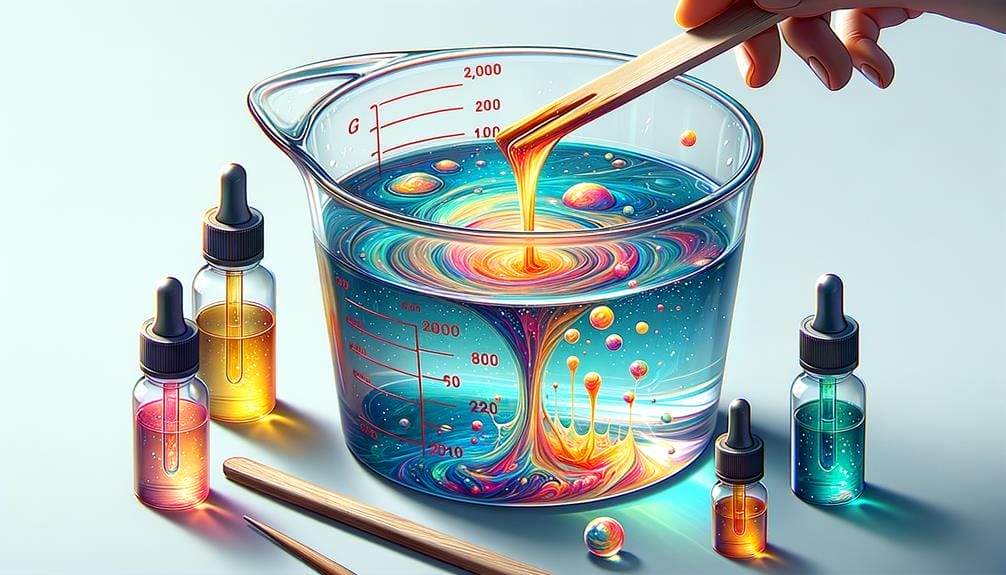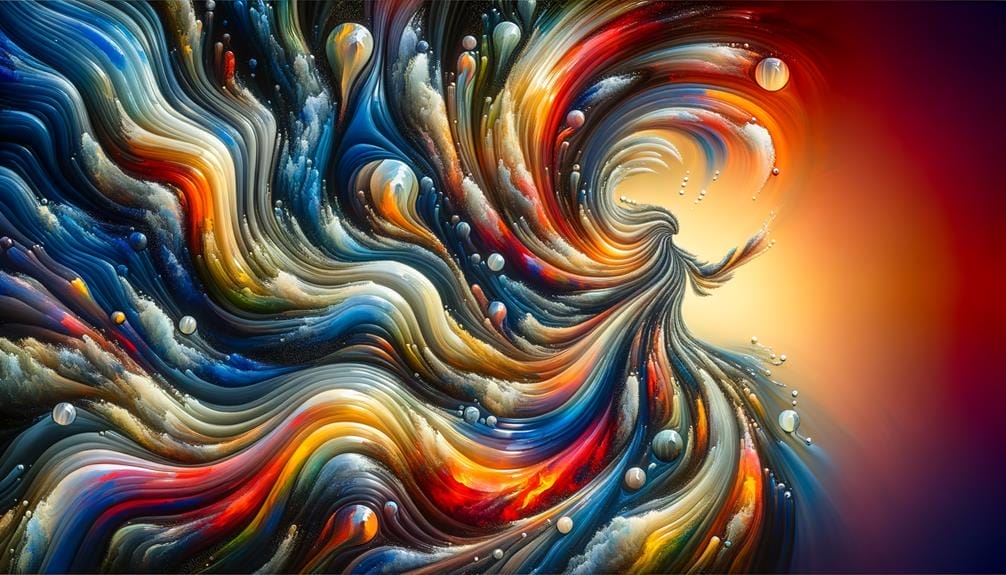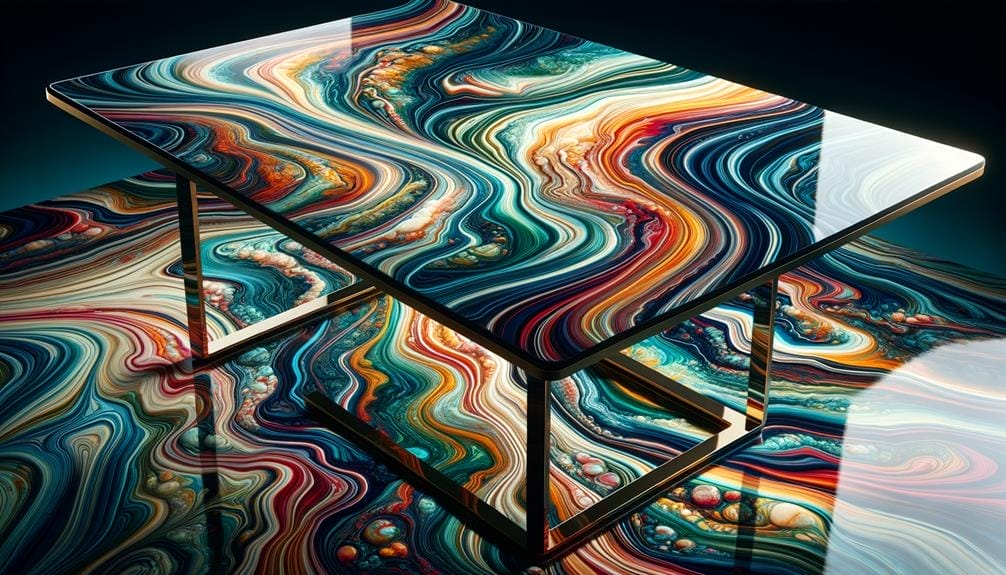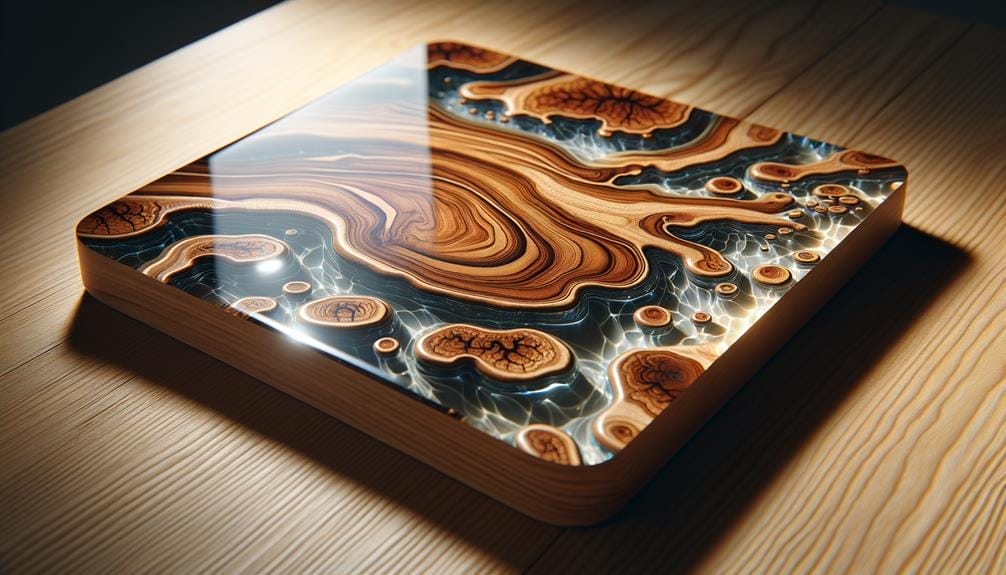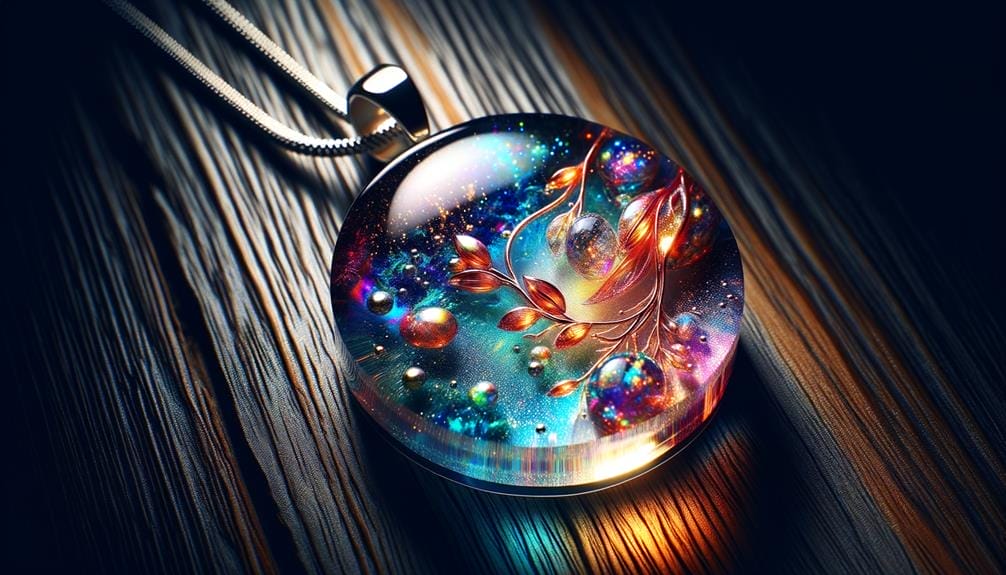Did you know that coloring epoxy resin has become a popular trend among DIY enthusiasts and artisans? The ability to add vibrant hues and unique effects to resin projects has captivated many creative minds. If you're curious about how to achieve stunning colors in your epoxy resin creations, you've come to the right place.
In this discussion, we will explore the various techniques and considerations when it comes to coloring epoxy resin. From controlling color intensity to enhancing your projects with shimmering pigments, we will guide you through the process step by step.
So, if you're ready to unlock the secrets of coloring epoxy resin, let's dive in and discover the endless possibilities that await!
Key Takeaways
- There are various options for coloring epoxy resin, including pigments, dyes, mica powders, alcohol inks, and acrylic paints.
- Mixing the coloring agent thoroughly and testing it on a small resin sample before applying it to the final project is recommended.
- Different effects and techniques, such as ombre, swirl, geode, resin tinting, and inclusion, can be used to create unique and visually interesting effects with colored epoxy resin.
- When working on large projects, it is important to divide the project into smaller sections, work on a clean and flat surface, and follow safety precautions to ensure a successful and safe coloring process.
Pigments and Dyes: Exploring Color Options
When exploring color options for your epoxy resin project, you have the choice between using pigments or dyes to achieve your desired effect.
Pigments, available as both powder and liquid forms, provide a wide range of color options for tinting epoxy resin. Powder pigments create irregular patterns, shimmer, or pearlescent effects, while liquid resin dyes offer smooth, even tones with no shimmer.
To achieve the desired color depth, liquid dyes can be gradually added, allowing for precise control. On the other hand, more mica powder pigments result in a darker and less translucent finish.
To create multiple shades, each pigment can be mixed into its own resin batch, with the pouring speed, batch size, and substrate shape all impacting the final patterns.
It's important to consider factors such as brightness, the complexity of patterns requiring control over resin flow, and the impact of the substrate color on the poured colors before starting a colorful epoxy project.
When choosing pigments or dyes, it's recommended to rely on reliable sources such as Pigmently, UltraClear Epoxy store, and brands recommended by UltraClear Epoxy to avoid low-quality products and resin scams.
Controlling Color Intensity in Epoxy Resin
To achieve precise control over the color intensity in your epoxy resin project, consider using a combination of pigments and dyes. By using both, you can gradually add the desired amount of color to achieve the perfect depth and vibrancy. Epoxy powder pigments and liquid resin dyes offer different effects, allowing you to experiment and create unique finishes.
When using pigments, such as mica powder, keep in mind that the more you add, the darker and less translucent the color will become. This can be advantageous if you want a bold and opaque look. On the other hand, liquid dyes provide smooth and even tones, making them ideal for achieving a more subtle and transparent effect.
To control the intensity of the color, start by adding a small amount of pigment or dye to your resin and mix it thoroughly. Gradually add more until you reach the desired color intensity. Remember to mix each pigment or dye into its own resin batch to create multiple shades. You can also pour tinted resin batches simultaneously to create attractive patterns and designs.
When planning your colorful epoxy project, consider the substrate color and resin flow. These factors can affect how the color appears once the resin has cured. Choose between pigments and dyes based on the brightness and effect you want to achieve.
For reliable sources of epoxy pigments and dyes, consider brands like UltraClear Epoxy and Pigmently. They offer premium powder pigments and resin dyes that will help you achieve the desired color intensity in your epoxy resin projects.
Enhancing Your Project With Epoxy Powder Pigments
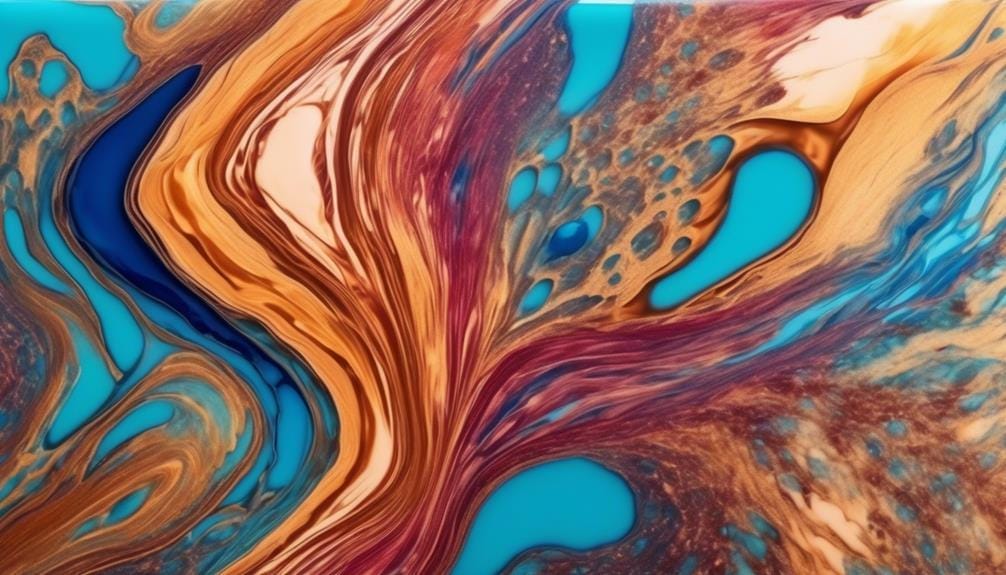
When enhancing your epoxy resin project with epoxy powder pigments, it's important to choose the right pigments that will complement your desired color palette.
Once you have selected your pigments, mix them into separate batches of epoxy resin to create different colors for your project.
When applying the pigmented resin, be mindful of the desired effect you want to achieve and carefully layer and manipulate the colors to create stunning and unique patterns.
Choosing the Right Pigments
For a truly mesmerizing effect in your epoxy project, enhance it with the stunning shimmer and pearlescent beauty of epoxy powder pigments.
When choosing the right pigments, consider the following:
- Amount of Colorant: The amount of powder pigment you use will determine the intensity of the color. Start with a small amount and gradually add more until you achieve the desired shade.
- Use Acrylic Paint: If you want to experiment with different colors, you can mix acrylic paint with your epoxy resin. This allows for a wider range of hues and shades.
- Mixing Ratio: Different types of epoxy resin may require different mixing ratios for the pigments. Follow the instructions provided by the manufacturer to ensure the best results.
- Types of Epoxy Resin: Some epoxy resins may not be compatible with certain pigment types. It's important to choose pigments that are specifically designed for use with epoxy resin.
- Resin Colorants: In addition to powdered pigments, you can also find liquid resin dyes that provide a smooth, even tone without shimmer. These can be gradually added to achieve the desired color depth.
- Metallic Pigments: If you want to add a touch of luxury to your project, consider using metallic pigments. These pigments create a stunning metallic effect that adds depth and dimension to your epoxy project.
Mixing the Epoxy Resin
Enhance your epoxy project with the mesmerizing shimmer and pearlescent beauty of epoxy powder pigments by incorporating them into the mixing process.
To begin, prepare the epoxy resin according to the manufacturer's instructions. Measure the appropriate amount of epoxy resin and pour it into a mixing container.
Next, add the desired amount of epoxy powder pigment to the resin. Start with a small amount and gradually increase until the desired color is achieved. Mix the pigment and resin thoroughly, ensuring that there are no streaks or clumps. The colorant should be evenly distributed throughout the mixture.
Remember to work quickly, as epoxy resin has a limited working time. Once the color is thoroughly mixed, pour the resin into your project, and watch as the vibrant hues come to life.
The addition of epoxy powder pigments will transform your epoxy project into a stunning work of art.
Applying the Pigmented Resin
As you pour the beautifully pigmented resin into your project, prepare to be captivated by the enchanting patterns and shimmering effects created by the incorporation of epoxy powder pigments during the mixing process. The application of pigmented resin is a crucial step in bringing your epoxy project to life.
Here's what you need to know:
- Gradually add liquid resin dye to control the depth and intensity of color in your epoxy mixture.
- Mix different pigments into separate resin batches to create multiple shades for your project, considering resin working time and pouring techniques.
- Choose between liquid dyes and pigments based on the substrate color and desired effect.
Considerations Before Starting a Colorful Epoxy Project
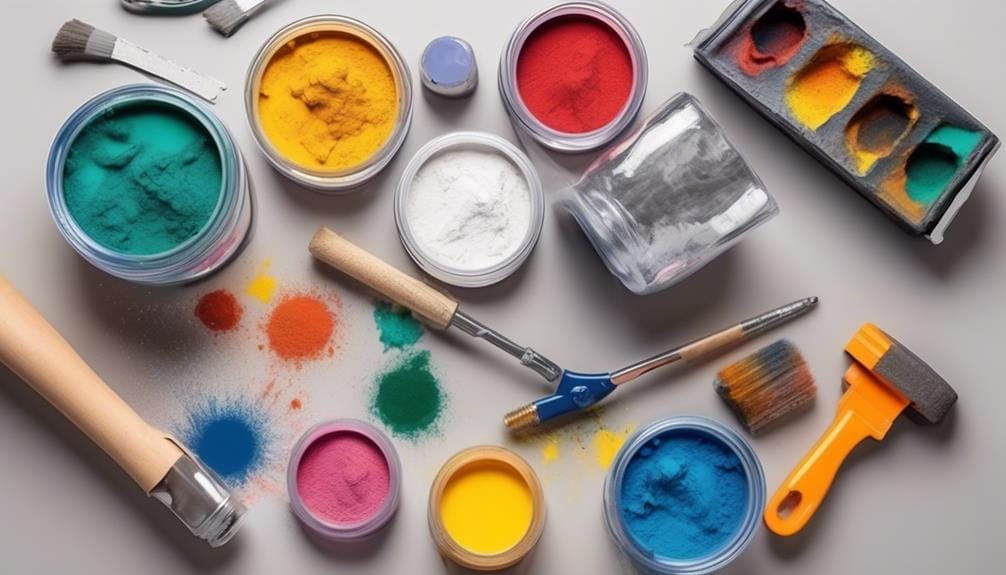
Before diving into your colorful epoxy project, there are a few important considerations to keep in mind.
Coloring epoxy can be a fun and creative process, but it's crucial to plan ahead to achieve the desired results.
First and foremost, choose the right colorant for your project. You can opt for epoxy powder pigments or liquid resin dyes, depending on the effect and color intensity you want to achieve. If using liquid dyes, remember to add them gradually to achieve the desired color depth. It's important to note that adding too much colorant can't be undone, so use a small amount at a time.
When using epoxy powder pigments, consider the working time of the resin. This will affect your ability to create multiple shades, so plan accordingly. Additionally, take into account the color of the substrate you're working with. The pigment or dye you choose may appear subdued when poured onto a dark or colored surface.
Lastly, ensure you purchase high-quality colorants from reliable sources to ensure the success of your project. Remember, a little colorant goes a long way, so start with a small amount and add more as needed.
Keep these considerations in mind, and you'll be well on your way to creating beautiful, vibrant epoxy projects with clear, stunning colors.
Step-By-Step Guide to Coloring Epoxy With Powder Pigments
Now that you have chosen the right pigment for coloring your epoxy resin, it's time to dive into the step-by-step process.
First, mix the epoxy resin according to the instructions provided, ensuring that you have the correct ratio of resin and hardener.
Next, slowly add the powder pigment to the resin mixture, stirring thoroughly to achieve an even distribution.
Once the pigment is fully incorporated, you can apply the colored resin to your desired surface, taking care to follow the recommended curing time for optimal results.
Choosing the Right Pigment
To achieve stunning and unique effects when coloring epoxy resin, selecting the right pigment is crucial. Here are some tips to help you choose the perfect pigment for your epoxy:
- Epoxy Powder Pigments: These pigments are perfect for creating irregular patterns, shimmer, or pearlescent effects in your epoxy. They come in a wide range of colors and can be mixed to create custom shades.
- Liquid Resin Dyes: If you're looking for more control over the color depth, gradually add liquid resin dyes to your epoxy. Start with a small amount of colorant and add more until you achieve the desired hue.
- Food Coloring: If you're on a budget or want to experiment with different colors, you can use food coloring to dye epoxy. Just make sure to use a small amount and mix it thoroughly with the resin and hardener.
Remember to consider the working time of your epoxy and the pouring speed to create attractive resin patterns.
And for premium, high-quality pigment options, check out the UltraClear Epoxy store.
Mixing the Epoxy Resin
For a seamless and vibrant result, mastering the art of mixing epoxy resin with powder pigments is key.
When using colorants, it's important to start with a small amount and gradually add more as needed. This allows for better control over the color depth and ensures that the pigment is evenly distributed throughout the resin.
Mix the powder pigment into the epoxy resin while it's still in its liquid state. Use a stir stick or a small mixer to thoroughly mix the colorant into the resin, making sure there are no streaks or clumps.
It's important to work quickly, as epoxy resin has a limited working time before it starts to harden.
Applying the Colored Resin
As you dive into the world of applying colored resin, your previously mixed epoxy resin with powder pigments will now come to life in vibrant hues that will enhance your creations. Here's a step-by-step guide to help you apply the colored resin effectively:
- Prepare the surface: Make sure the surface you're working on is clean and free from any dust or debris. This will ensure a smooth application.
- Choose the coloring agent: There are several options you can use to color epoxy resin, such as alcohol ink, spray paint, mica, and even latex paint. Experiment with different coloring agents to find the best colorant for your project.
- Mix the coloring agent: Add a small amount of your chosen coloring agent to the epoxy resin and mix thoroughly. Start with a small amount and gradually add more until you achieve the desired color intensity.
- Apply the colored resin: Use a brush or spatula to apply the colored resin onto your project. Take your time and ensure even coverage.
- Cure the resin: Follow the manufacturer's instructions for curing the resin. This may involve letting it dry naturally or using a heat gun or UV light.
Step-By-Step Guide to Coloring Epoxy With Liquid Resin Dyes
Enhance your epoxy project with vibrant colors by following this detailed step-by-step guide to coloring epoxy using liquid resin dyes. Liquid resin dyes are a popular choice for adding different colors to epoxy resins, as they provide smooth, even tones without shimmer. By gradually adding the liquid dyes, you have control over the color depth, allowing you to achieve the desired shade.
To start, mix the resin according to the manufacturer's instructions. Once the resin is mixed, it's time to add the liquid resin dyes. Below is a step-by-step guide to coloring epoxy with liquid resin dyes:
| Step | Instructions |
|---|---|
| 1 | Begin by selecting the liquid resin dyes in the colors of your choice. |
| 2 | Start with a small amount of dye and gradually add it to the mixed resin. Mix thoroughly until the color is evenly distributed. |
| 3 | If you want to achieve multiple shades, mix each pigment into its own resin batch. |
| 4 | Pour the tinted resin batches simultaneously to create attractive patterns. |
| 5 | Allow the epoxy to cure according to the manufacturer's instructions.
Where to Find Reliable Powder Pigments and Resin Dyes
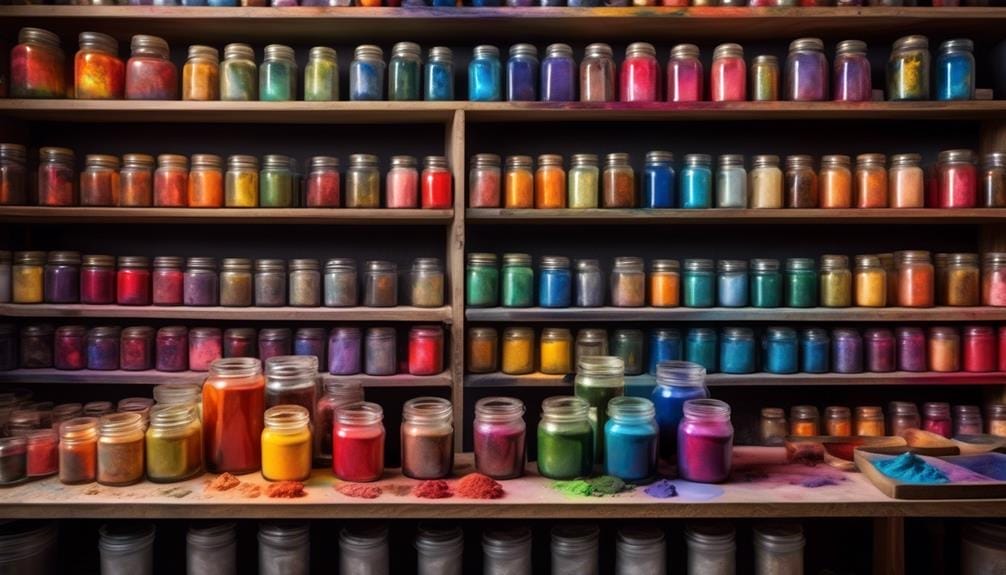
When searching for reliable powder pigments and resin dyes, look no further than Pigmently, a trusted source recommended by UltraClear Epoxy. Pigmently offers a wide range of high-quality colorants that can be used to color epoxy resin. Here's why Pigmently is the go-to choice for your coloring needs:
- Fine Powder: Pigmently provides fine powder pigments and resin dyes, ensuring smooth and even dispersion in your epoxy resin. This results in vibrant and consistent colors throughout your project.
- High Quality: Pigmently is known for its commitment to quality. Their pigments and dyes are carefully formulated and tested to meet the highest standards, guaranteeing excellent color retention and durability.
- Used to Color Small Quantities: Whether you're working on a small art piece or a large-scale project, Pigmently offers colorants in quantities suitable for any project size. You can easily measure and mix the desired amount without any waste.
Pigmently makes sure that their colorants are readily available for your convenience. Their user-friendly website allows you to browse and order the pigments and resin dyes you need with just a few clicks. With Pigmently, you can transform your epoxy resin projects into stunning works of art.
Additional Resources for Coloring Epoxy Resin
To further enhance your knowledge and skills in coloring epoxy resin, explore these valuable additional resources.
When it comes to tinting epoxy resin, Pigmently is a reliable source for premium powder pigments and resin dyes. Their wide variety of options allows you to choose the perfect color for your project.
Mica powder pigments are another fantastic option for coloring epoxy resin. As you add more mica powder, the color becomes darker and less translucent, giving you control over the intensity and depth of the color. However, it's important to mix well because mica particles have a tendency to sink to the bottom.
If you're looking for high-quality pigments and dyes, both the UltraClear Epoxy store and Pigmently come highly recommended. They offer a range of colors and ensure a successful coloring process.
Additionally, the ebook 'The Ugly Truth About Epoxy Resin: What Companies Don't Want You to Know' provides valuable insights to help you avoid resin scams and make informed purchasing decisions.
For detailed guidance on coloring epoxy resin with different techniques and applications, you can find digital instructions for UltraClear Table Top Epoxy and UltraClear Deep Pour Epoxy. These resources will further expand your expertise and help you achieve stunning results in your epoxy resin coloring endeavors.
Frequently Asked Questions
What Can I Use to Color Epoxy Resin?
You can use alcohol ink, mica powder, resin dyes, natural pigments, resin tints, and resin metallic powders to color epoxy resin. Experiment with different techniques to create marbled effects and achieve vibrant, unique looks.
Can You Mix Acrylic Paint With Epoxy Resin?
You can mix acrylic paint with epoxy resin, but there are pros and cons. Acrylic paint can create vibrant colors, but adding too much can thicken the epoxy. Experiment and avoid common mistakes for unique results.
How Do You Color Resin for Beginners?
To color resin for beginners, start with resin pigments or acrylic paint. Mix colors for unique effects, aiming for transparent or opaque colors. To achieve vibrant shades, use metallic powders or create marbled effects. Troubleshoot common color issues for a flawless finish.
Can Clear Epoxy Be Tinted?
Yes, clear epoxy can be tinted using various options. You can use pigments, natural dyes, or alcohol inks to achieve vibrant colors. Experiment with different techniques, like marbling, to create unique and translucent effects.
Conclusion
As you dive into the world of coloring epoxy resin, you'll discover endless possibilities for creating stunning and unique pieces. Whether you choose liquid dyes for a smooth and even tone or powder pigments for captivating patterns and shimmer, the key is finding the right balance.
Remember, like mixing paints on a canvas, the artistry lies in your ability to control color intensity and create a masterpiece that truly reflects your vision.
So go forth, embrace your creativity, and let your epoxy resin creations shine like stars in the night sky.

